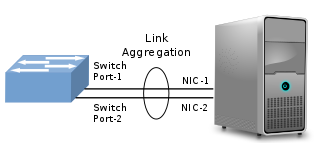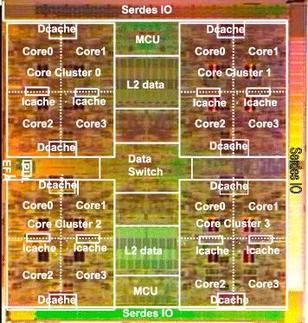Related Research Articles

In computer networking, Gigabit Ethernet is the term applied to transmitting Ethernet frames at a rate of a gigabit per second. The most popular variant, 1000BASE-T, is defined by the IEEE 802.3ab standard. It came into use in 1999, and has replaced Fast Ethernet in wired local networks due to its considerable speed improvement over Fast Ethernet, as well as its use of cables and equipment that are widely available, economical, and similar to previous standards. The first standard for faster 10 Gigabit Ethernet was approved in 2002.
In the seven-layer OSI model of computer networking, the physical layer or layer 1 is the first and lowest layer: the layer most closely associated with the physical connection between devices. The physical layer provides an electrical, mechanical, and procedural interface to the transmission medium. The shapes and properties of the electrical connectors, the frequencies to broadcast on, the line code to use and similar low-level parameters, are specified by the physical layer.

A network interface controller is a computer hardware component that connects a computer to a computer network.
TCP offload engine (TOE) is a technology used in some network interface cards (NIC) to offload processing of the entire TCP/IP stack to the network controller. It is primarily used with high-speed network interfaces, such as gigabit Ethernet and 10 Gigabit Ethernet, where processing overhead of the network stack becomes significant. TOEs are often used as a way to reduce the overhead associated with Internet Protocol (IP) storage protocols such as iSCSI and Network File System (NFS).
10 Gigabit Attachment Unit Interface is a standard for extending the XGMII between the MAC and PHY layer of 10 Gigabit Ethernet (10GbE) defined in Clause 47 of the IEEE 802.3 standard. The name is a concatenation of the Roman numeral X, meaning ten, and the initials of "Attachment Unit Interface".

QEMU is a free and open-source emulator. It emulates the machine's processor through dynamic binary translation and provides a set of different hardware and device models for the machine, enabling it to run a variety of guest operating systems. It can interoperate with Kernel-based Virtual Machine (KVM) to run virtual machines at near-native speed. QEMU can also do emulation for user-level processes, allowing applications compiled for one architecture to run on another.

The Sun Ray was a stateless thin client computer aimed at corporate environments, originally introduced by Sun Microsystems in September 1999 and discontinued by Oracle Corporation in 2014. It featured a smart card reader and several models featured an integrated flat panel display.

In computer networking, link aggregation is the combining of multiple network connections in parallel by any of several methods. Link aggregation increases total throughput beyond what a single connection could sustain, and provides redundancy where all but one of the physical links may fail without losing connectivity. A link aggregation group (LAG) is the combined collection of physical ports.

The 10 Gigabit Ethernet Alliance (10GEA) was an independent organization which aimed to further 10 Gigabit Ethernet development and market acceptance. Founded in February 2000 by a consortium of companies, the organization provided IEEE with technology demonstrations and specifications. Its efforts bore fruit with the IEEE Standards Association (IEEE-SA) Standards Board's approval in June 2002 of the IEEE 802.3 standard.
Sun Microsystems' UltraSPARC T1 microprocessor, known until its 14 November 2005 announcement by its development codename "Niagara", is a multithreading, multicore CPU. Designed to lower the energy consumption of server computers, the CPU typically uses 72 W of power at 1.4 GHz.
The Sun Fire 15K was an enterprise-class server computer from Sun Microsystems based on the SPARC V9 processor architecture. It was announced on September 25, 2001, in New York City, superseding the Sun Enterprise 10000. General availability was in January 2002; the last to be shipped was in May 2005.

Rock was a multithreading, multicore, SPARC microprocessor under development at Sun Microsystems. Canceled in 2010, it was a separate project from the SPARC T-Series (CoolThreads/Niagara) family of processors.

Sun Microsystems' UltraSPARC T2 microprocessor is a multithreading, multi-core CPU. It is a member of the SPARC family, and the successor to the UltraSPARC T1. The chip is sometimes referred to by its codename, Niagara 2. Sun started selling servers with the T2 processor in October 2007.
The current portfolio of PowerConnect switches are now being offered as part of the Dell Networking brand: information on this page is an overview of all current and past PowerConnect switches as per August 2013, but any updates on current portfolio will be detailed on the Dell Networking page.

RMI Corporation, formerly Raza Microelectronics, Inc., was a privately held fabless semiconductor company headquartered in Cupertino, California, which specialized in designing system-on-a-chip processors for computer networking and consumer media applications.

The Ultra 24 is a family of computer workstations by Sun Microsystems based on the Intel Core 2 processor.

The UltraSPARC II, code-named "Blackbird", is a microprocessor implementation of the SPARC V9 instruction set architecture (ISA) developed by Sun Microsystems. Marc Tremblay was the chief architect. Introduced in 1997, it was further development of the UltraSPARC operating at higher clock frequencies of 250 MHz, eventually reaching 650 MHz.
The SPARC T3 microprocessor is a multithreading, multi-core CPU produced by Oracle Corporation. Officially launched on 20 September 2010, it is a member of the SPARC family, and the successor to the UltraSPARC T2.
EqualLogic, Inc. was an American computer data storage company based in Nashua, New Hampshire, active from 2001 to 2007. In 2008, the company was merged into Dell Inc. Dell-branded EqualLogic products are iSCSI-based storage area network (SAN) systems. Dell has 3 different lines of SAN products: EqualLogic, Compellent and Dell PowerVault.
Dell Networking is the new name for the networking portfolio of Dell. In the first half of 2013, Dell started to rebrand their different existing networking product brands to Dell Networking. Dell Networking is the new name for the networking equipment that was known as Dell PowerConnect, as well as the Force10 portfolio.
References
- ↑ Ashlee Vance (April 3, 2007). "Marvell gets [SIC] on Sun's NIC: Licensee located on Neptune". The Register. Archived from the original on October 12, 2012. Retrieved May 22, 2013.
- 1 2 "10 Gigabit Ethernet on UltraSPARC T2 – weblog from Pure See". Archived from the original on 2017-04-24.